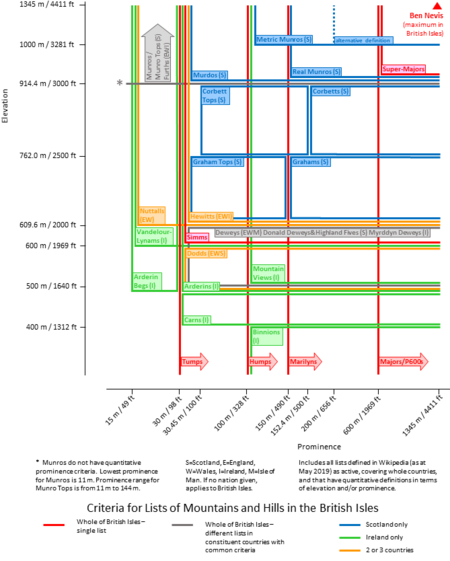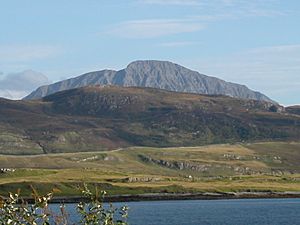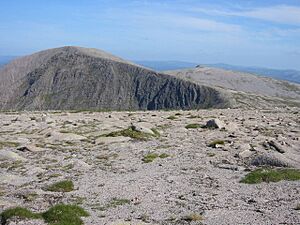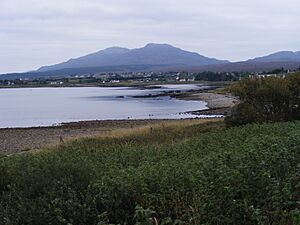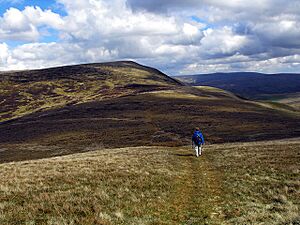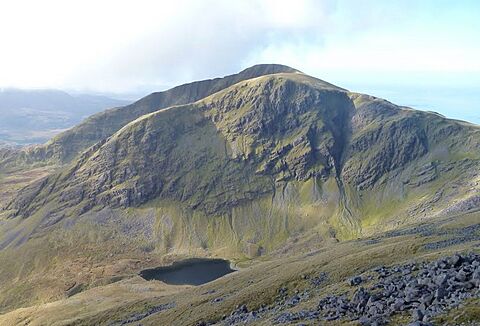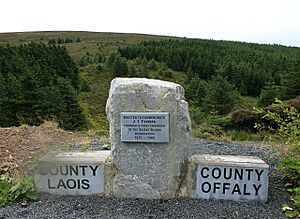Lists of mountains and hills in the British Isles facts for kids
The mountains and hills in the British Isles are grouped into different lists. These lists are based on how high they are, how much they stand out from the land around them (called "prominence"), and other things. People who love to hike often try to climb all the mountains on a specific list. The oldest list is the 282 Munros in Scotland, which was created way back in 1891.
In the British Isles, a peak usually needs to be taller than 2,000 feet (or 610 meters) to be called a "mountain" instead of a "hill." Most lists also require a mountain to have a prominence of at least 15 meters (about 49 feet). If a peak has a prominence between 15 and 30 meters, it might not be seen as a truly "independent peak" by some international groups. Many lists call peaks with a prominence between 30 and 150 meters "tops."
The Marilyns are different because they only care about prominence (over 150 meters), not height. So, a Marilyn can be a small 150-meter hill or a huge mountain. Mountains with a prominence over 600 meters are called P600s, which are considered "major" mountains internationally.
Contents
- What Makes a Mountain a Mountain?
- Mountains Across the British Isles
- Mountains Only in Scotland
- Mountains Outside Scotland
- Mountains Only in England
- Mountains Only in Ireland
- Mountains Only in Wales
- County Tops
- Other Active Lists
- Older Lists (Not Actively Updated)
- Regional Lists
- See also
- Images for kids
What Makes a Mountain a Mountain?
How High Is It?
There's no single rule for what makes a mountain different from a hill around the world. But in Great Britain and Ireland, a mountain is usually a summit that's at least 2,000 feet (or 610 meters) high. The UK government even uses 600 meters as the height for land where people have the right to roam freely. For example, when Calf Top in Cumbria was measured again in 2016, it was found to be just 6 millimeters over the 2,000-foot mark. The Ordnance Survey then called it England's "last mountain."
Sometimes, what we call a mountain also depends on local traditions. In Scotland, even very tall mountains like the Cuillin Hills are often called "hills."
How Much Does It Stand Out?
Most mountain lists in the British Isles use a minimum "prominence" rule. Prominence means how much a peak rises above the lowest point connecting it to a higher peak. This is usually between 30 and 600 meters (about 98 to 1,968 feet).
The smallest prominence needed for some lists is 15 meters (like for Nuttalls). But most lists require more than 30 meters. Many lists use the word "Tops" for peaks that have a prominence between 30 and 150 meters. Other lists, like P600s and Marilyns, focus only on prominence, not height.
The International Climbing and Mountaineering Federation (UIAA) has its own rules. In 1994, they said an "independent peak" needs to stand out by more than 30 meters. A "mountain" needs to stand out by more than 300 meters (about 984 feet).
Measuring prominence can be tricky because it involves looking at all the land around a peak. So, lists based on prominence can change over time. Some lists use feet for height and meters for prominence.
How Isolated Is It?
No British Isles list uses a specific measurement for how "isolated" a mountain is (like how far it is from the next point of the same height). However, the idea of "enough separation" is part of the definition for a Scottish Munro.
The Database of British and Irish Hills
The Database of British and Irish Hills (DoBIH) was started in 2001. It helps hikers find a complete and up-to-date list of British hills. A team of seven editors keeps it updated. It's considered the most reliable online source for all mountain lists. Many books, websites, and apps use the DoBIH as their source.
You can download the DoBIH or use its online version called Hill Bagging. As of July 2023, it had 20,742 hills! This includes all the Marilyns, HuMPs, TuMPs, Simms, Munros, and many, many more.
Since 2012, the DoBIH has shared information with MountainViews, an Irish online database.
Mountains Across the British Isles
P600 (The "Majors")

The P600s are mountains in the British Isles that stand out by at least 600 meters (about 1,968 feet), no matter how tall they are. This list is one of the shortest because it has very strict rules.
In 2006, there were 93 P600s in Great Britain: 82 in Scotland, four in England, and seven in Wales. With one in Northern Ireland, one on the Isle of Man, and 24 in the Republic of Ireland, the total for the British Isles was 119. The number has changed a little since then due to new measurements.
The P600s include 54 of Scotland's 282 Munros. They also include 10 of the 34 "Furths" (mountains outside Scotland that are like Munros). These 64 mountains are over 3,000 feet tall and stand out by at least 600 meters.
P600 is an international way to classify mountains. There's also P1500 (or "Ultras") for mountains that stand out by over 1,500 meters (about 4,921 feet). The online Database of British and Irish Hills also lists P500 mountains, which stand out by over 500 meters.
Marilyns
Marilyns are mountains and hills in the British Isles that stand out by more than 150 meters (about 492 feet), no matter how tall they are. As of 2020, there were 1,552 Marilyns in Great Britain: 1,219 in Scotland, 175 in England, and 158 in Wales. There are also 454 Marilyns in Ireland and five on the Isle of Man, making a total of 2,011 for the British Isles.
Alan Dawson first put this list together in 1992. The name "Marilyn" is a funny play on "Munro," sounding like Marilyn Monroe. Marilyns are very popular for "peak bagging" because they include all sorts of hills and mountains, even some sea stacks.
HuMPs
The Marilyns list was made bigger in 2007 with the HuMPs (Hundred and upwards Metre Prominence). These are hills that stand out by at least 100 meters (about 328 feet). All Marilyns are HuMPs, but not all HuMPs are Marilyns. As of April 2020, there were 2,984 HuMPs in the British Isles.
Simms
A Simm is a mountain in the British Isles that is over 600 meters (about 1,968 feet) high and stands out by at least 30 meters (about 98 feet). The name comes from "Six-hundred Metre Mountain." As of April 2020, there are 2,755 Simms in the British Isles. All Simms are also TuMPs (see below). The idea for Simms was introduced in 2010 as a clear way to define a mountain in Britain.
TuMPs
In 2010, the HuMPs list was made even bigger with the TuMPs (Thirty and upwards Metre Prominence). These are all hills in Britain that stand out by more than 30 meters (about 98 feet). As of April 2020, there are 17,127 TuMPs! Many of these were found by Mark Jackson between 2006 and 2009. Since 2012, the Database of British and Irish Hills has kept this list updated.
Mountains Only in Scotland
Munros
Munros are famous mountains in Scotland that are over 3,000 feet (about 914 meters) tall. The list was first made by Sir Hugh Munro in 1891. The Scottish Mountaineering Club (SMC) updates it sometimes. Unlike other lists, Munros don't have a strict prominence rule. Instead, they are chosen if they feel like a "separate mountain." Smaller peaks connected to them are called Munro Tops. There are 282 Munros and 226 Munro Tops, all in the Scottish Highlands.
"Real Munros" are Munros that stand out by over 150 meters (like a Marilyn). There are 202 of these. Also, 54 Munros are tall enough and stand out enough to be P600s.
Murdos
Murdos are all the summits in Scotland over 3,000 feet (about 914 meters) that stand out by more than 30 meters (about 98 feet). There are 442 Murdos. One Munro (Maoile Lunndaidh) is not a Murdo, and 66 Munro Tops are not Murdos.
Alan Dawson created this list in 1995 as a more objective way to define Munros. His 30-meter prominence rule matches what the UIAA said in 1994 for an "independent peak." The SMC doesn't officially keep a list of Murdos, but all Murdos are either Munros or Munro Tops.
Corbetts
Corbetts are peaks in Scotland that are between 2,500 and 3,000 feet (about 762 and 914 meters) tall and stand out by at least 500 feet (about 152 meters). John Rooke Corbett, a climber, made this list in the 1920s. As of April 2020, there are 222 Corbetts. People who climb all of them are called "Corbetteers."
There are also 455 "Corbett Tops," which are mountains in Scotland between 2,500 and 3,000 feet tall with a prominence between 100 and 500 feet.
Grahams
Grahams are hills in Scotland between 600 and 762 meters (about 1,968 and 2,500 feet) tall, and they stand out by at least 150 meters (about 492 feet). Alan Dawson first published a list of these hills in 1992. The name "Grahams" comes from Fiona Torbet (whose maiden name was Graham), who published her own list. As of December 2022, there are 231 Grahams.
Donalds
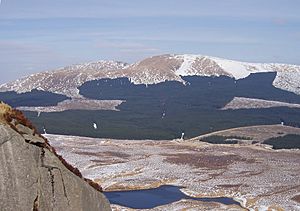
Donalds are mountains in the Scottish Lowlands that are over 2,000 feet (about 610 meters) tall, among other things. Percy Donald made this list in 1935. The SMC keeps it updated. The rules for Donalds are a bit complex and include "Donald Hills" and "Donald Tops." Donald Hills usually stand out by over 100 feet, but Donald Tops can vary. As of April 2020, there are 140 Donalds.
Because the Donald rules are complicated, a simpler list called "New Donalds" was created in 1995. These have a clear prominence rule of 30 meters. There are 118 New Donalds.
Hughs
The Hughs (Hills Under Graham Height) are a list made by Andrew Dempster. He describes them as "hills with attitude, not altitude" and focuses on how much they stand out, their location, and the views they offer. He listed 100 summits in mainland Scotland in 2015.
Mountains Outside Scotland
Furths
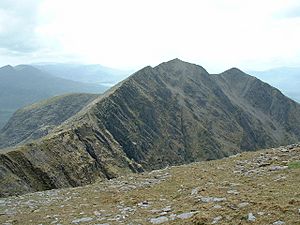
Furths are mountains in Great Britain and Ireland that are "outside" (or furth of) Scotland, but would otherwise be Munros or Munro Tops. They are sometimes called the Irish, English, or Welsh Munros. There are 34 Furths: 15 in Wales, 13 in Ireland, and six in England. The tallest is Snowdon. Most Furths stand out by more than 30 meters.
The Scottish Mountaineering Club (SMC) keeps track of the Furths and celebrates climbers who complete them ("Furthists").
Hewitts
The Hewitts are "hills in England, Wales and Ireland over two thousand" feet (609.6 meters) tall, that stand out by at least 30 meters (about 98 feet). The lists for England and Wales were made by Alan Dawson. The Irish list was made by Clem Clements. This list is a smaller group of the Nuttall classification (see below).
As of March 2019, there were 525 Hewitts: 209 in Ireland, 180 in England, and 136 in Wales. Hewitts are similar to the newer "Simms" classification, which uses a 600-meter height rule and a 30-meter prominence rule.
Nuttalls
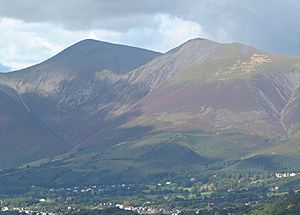
The Nuttalls are mountains only in England and Wales that are over 2,000 feet (about 610 meters) tall and stand out by at least 15 meters (about 49 feet). John and Anne Nuttall created the original list of 444 Nuttalls in 1989–90. After updates, there are now 446 Nuttalls.
Some people think the Nuttalls list includes too many small peaks because the prominence rule is quite low. The Hewitts list tries to fix this by having a higher prominence rule. Most Nuttalls can be climbed without special rock climbing gear, except for Pillar Rock in the Lake District.
Mountains Only in England
Wainwrights
The Wainwrights are mountains or hills (called "fells") in the English Lake District National Park. They are included in one of Alfred Wainwright's Pictorial Guides to the Lakeland Fells. There are 214 Wainwrights in his seven guides. Wainwright chose them, but he generally included summits over 1,000 feet tall with a prominence over 50 feet. One exception was Castle Crag, which was just under 1,000 feet but Wainwright felt it was a "perfect mountain in miniature." Another 116 summits are in a separate guide called The Outlying Fells of Lakeland.
Birketts
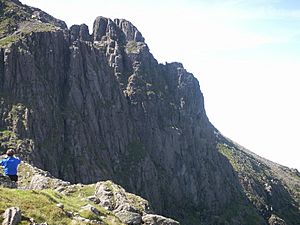
The Birketts are all the peaks over 1,000 feet (about 305 meters) within the Lake District National Park. Their height and location matter, but not how much they stand out. Bill Birkett created this list for his 1994 book Complete Lakeland Fells. There are 541 Birketts. They include 209 of the 214 Wainwrights.
Synges
The Database of British and Irish Hills lists the Synges, which are 647 Lake District summits from Tim Synge's 1995 book The Lakeland Summits. There's no specific height or prominence rule for these.
Mountains Only in Ireland
Vandeleur-Lynams
A Vandeleur-Lynam is like an Irish Nuttall, but it uses metric measurements. It requires a height of 600 meters (about 1,968 feet) and a prominence of 15 meters (about 49 feet). Like Nuttalls, these don't always meet international definitions for a "peak" or "mountain." Irish climber Joss Lynam first made a list in 1952. There are 275 Vandeleur-Lynams in Ireland.
Arderins
The Arderins are mountains in Ireland over 500 meters (about 1,640 feet) tall, that stand out by more than 30 meters (about 98 feet). The name comes from the 527-meter hill Arderin, which means "Height of Ireland." According to the MountainViews Online Database, Ireland has 407 Arderins.
There are also "Arderin Begs" for peaks over 500 meters tall that stand out by 15 to 30 meters. In 2018, Ireland had 124 of these.
MountainViews
In 2013, Simon Stewart, who runs the Irish mountain database MountainViews Online Database, suggested a new way to classify Irish mountains. These would be over 500 meters tall and stand out by more than 100 meters (about 328 feet). He found 222 such peaks. MountainViews used this idea to create a popular list of the "100 Highest Mountains in Ireland."
Carns
MountainViews and the Database of British and Irish Hills list 337 summits as Carns. These are between 100 and 400 meters (about 328 and 1,312 feet) tall and stand out by over 30 meters (about 98 feet).
Binnions
MountainViews and the Database of British and Irish Hills list 484 summits as Binnions. These stand out by at least 100 meters (about 328 feet) but are shorter than 400 meters (about 1,312 feet). The name might come from Binnion Hill in County Donegal.
Mountains Only in Wales
The Mud and Routes website has a list called WASHIS: Welsh And Six Hundred In Stature. These are 118 summits over 600 meters (about 1,969 feet) that stand out by at least 50 meters. However, this name isn't widely used.
County Tops
Climbing to the highest point in each county is a fun type of "peak bagging." This tradition goes back to the 1920s.
- List of counties of England and Wales in 1964 by highest point
- List of ceremonial counties of England by highest point
- List of Welsh principal areas by highest point
- List of Scottish counties by highest point
- List of Scottish council areas by highest point
- List of Irish counties by highest point
Other Active Lists
Deweys
The Deweys and related lists extend the Hewitts to include mountains down to 500 meters (about 1,640 feet). They also include summits in Scotland, where there are no Hewitts.
- The Deweys are peaks in England, Wales, and the Isle of Man between 500 meters and 2,000 feet tall. They stand out by over 30 meters. Michael Dewey listed them in 1995. There are 426 Deweys.
- The Donald Deweys are peaks in the Scottish lowlands (like the Donalds) between 500 meters and 2,000 feet tall. They stand out by over 30 meters. David Purchase listed them in 2001. There are 248 Donald Deweys.
- The Highland Fives are peaks in the Scottish highlands between 500 meters and 2,000 feet tall. They stand out by over 30 meters. The Database of British and Irish Hills now maintains this list. There are 774 Highland Fives.
- The Myrddyn Deweys are peaks in Ireland between 500 meters and 2,000 feet tall. They stand out by over 30 meters. Michael Dewey and Myrddyn Phillips listed them in 2000. There are 200 Myrddyn Deweys.
Dodds
The Dodds are hills between 500 and 600 meters tall that stand out by over 30 meters. This list was created in 2014 to combine parts of the Deweys, Donald Deweys, and Highland Fives that are below 600 meters. The name "Dodds" comes from "Donald Deweys, Deweys and Scotland." The Database of British and Irish Hills maintains this list.
Hardys
A Hardy is the highest point of a UK, Manx, or Channel Island hill range, a UK island bigger than 4.05 square kilometers, or a top-level administrative area (like a county). There are 347 Hardys. Ian Hardy first made this list in the 1990s.
Older Lists (Not Actively Updated)
Bridges
The Database of British and Irish Hills recognizes the 407 summits from George Bridge's 1973 book Mountains of England and Wales. This list was later replaced by the Nuttalls.
Buxton & Lewis
The Database of British and Irish Hills recognizes the 422 summits from Chris Buxton and Gwyn Lewis's 1986 book Mountain Summits of England and Wales. This list is similar in size to the Nuttalls.
Clems
The Database of British and Irish Hills recognizes the 1,284 summits from E. D. Clements' 1993 list Yeamans of England & Wales. These were named Clems after his death and helped create the HuMPs list.
Fellrangers
The Database of British and Irish Hills recognizes the 230 Lake District summits from Mark Richards' Fellranger guidebooks. There's no height or prominence rule for these.
Yeamans
The Database of British and Irish Hills recognizes the 2,441 summits from Eric Yeaman's 1989 book Handbook of the Scottish Hills. This list is now considered "historic" and hasn't been updated since 2001.
Regional Lists
Here are some lists of hills for specific regions in the British Isles:
England:
- List of hills of Cornwall
- List of hills of Dorset
- List of hills of Gloucestershire
- List of hills of Hampshire
- List of hills of Wiltshire
- List of hills in the Peak District
See also
- List of mountain lists
- Lists of mountains
- List of mountains of the British Isles by height
Images for kids
-
Scafell Pike in the Lake District in Cumbria. Scafell Pike is the highest mountain in England.


